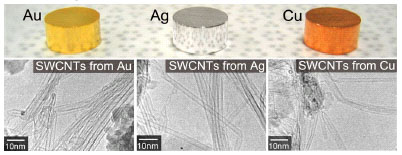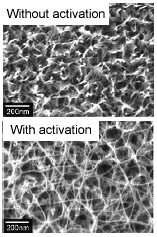Daisuke Takagi1 and Hiroki Hibino2
1Tokyo University of Science, 2Materials Science Laboratory
CVD, in which carbon-containing precursor molecules like ethanol or methane reacts with metal catalyst nanoparticles at elevated temperature, is the most common SWCNT synthesis process being investigated toward practical applications. Iron-group elements and their alloys (Co-Mo, Fe-Co etc) have been mainly used as the catalyst materials for CVD growth. On the other hand, gold-group elements have been regarded as the most unlikely elements to produce SWCNTs since it has been assumed that catalysts must have an affinity for carbon, e.g. high solubility and compound formation. The results of our work (Fig.1) overrule this assumption and indicate that SWCNTs can be formed from gold-group elements, which have extremely low solubility of carbon in bulk phase. The traditional CVD growth mechanism is based on the consideration of the affinity between carbon and catalyst species. In this study, we demonstrated that gold-group elements act as highly efficient catalysts for CVD synthesis of SWCNTs under the following three conditions: (1) Very small metal nanoparticles (3 nm or less in diameter). (2) For activation (Fig. 2), heat-treatment at high temperature (〜900℃) in air for cleaning of catalyst surfaces. (3) High growth temperature for thermal decomposition of carbon-containing precursor molecules. Moreover, this recipe is also effective for other various metals, such as platinum-group elements (Rh, Pd and Pt), and results in high-density SWCNT yields by CVD. These results mean that the catalytic function for SWCNT synthesis is not specific to the properties of iron-group elements, such as solubility of carbon and precipitation of graphite. Therefore, the CVD growth mechanism from catalyst particles should be reconsidered taking this fact into account. The availability of novel catalyst materials will push the development of growth processes for precise control of SWCNT structures and their non-ferromagnetic properties and catalytic activities for semiconductor nano-wire growth will lead to new applications of SWCNTs in industries.
[1] D. Takagi, et al., Nano Lett. 6 (2006) 2642.
 |
 |
|||||
|
|